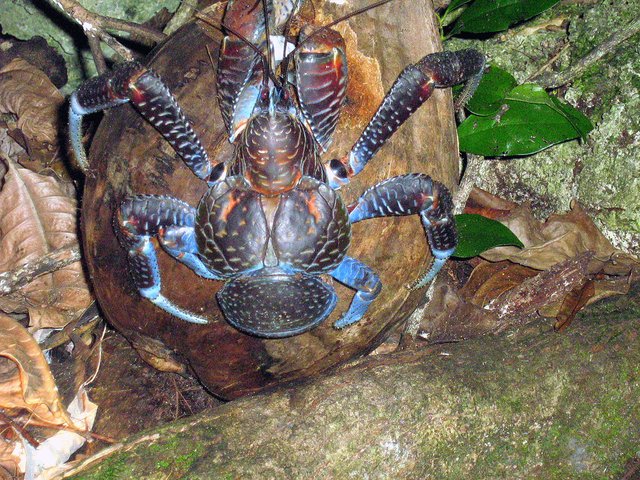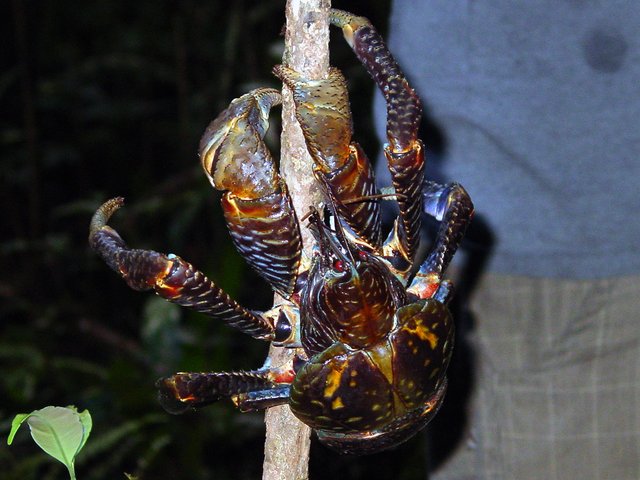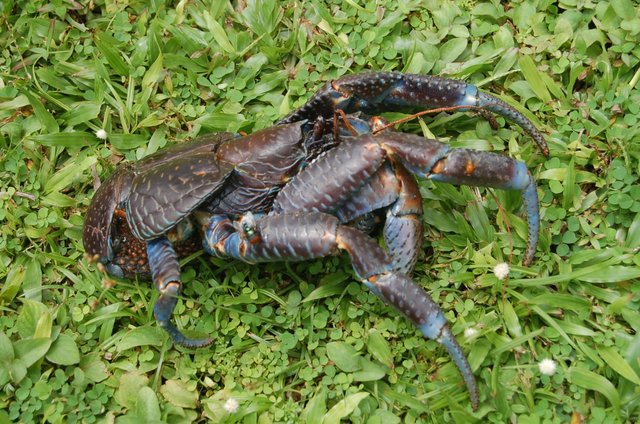The incredible strength of the Coconut crab (Amazing Animal Adaptations #1)
The Coconut crab (Birgus latro) is a terrestrial hermit crab that is known for its incredible pinch strength. It is also the largest land-living arthropod (an invertebrate animal with an exoskeleton, segmented body and jointed appendages), and some individuals can grow up to be just over 4kg / 9 lb large. Their body can be up to 40 cm / 16 in long, so this is a really big crab! It is adapted to live all of its life on land, and does not even have the necessary adaptations to stay underwater for more than a short while.
The coconut crab is found on islands all across the Indian Ocean, as well as parts of the Pacific Ocean. It used to be found anywhere near the Indian and Pacific Ocean where there were coconut palms, but humans have led them to local extinction in most populated places, such as mainland Australia and Madagascar.

A coconut crab on top of a coconut. Image by fearlessRich, posted under the Creative Commons Attribution 2.0 Generic license.
The size and body mass is really cool, but it is not these attributes of the coconut crab that are most amazing about it. It is the sheer amount of force it can produce from its pinch. A group of Japanese researchers recently tried to measure the force of its pinch, with several individuals from different size brackets. They found out that one of the males weighing 2070g has a force of 180.0 kgf, which is equivalent of 1765.2 N. This is extremely high, and the study also finds that their force correlates with their body weight. Taking this into account, we can expect that the largest individuals at about 4kg body weight to have a pinching force of about 3,300 Newton!
3,300 Newton is an incredible pinch strength, which is far greater than most of the biting force of most terrestrial predators (with only some exceptions, mainly from alligators). A coconut crab is also able to carry 4 times its body weight, meaning a 4kg crab can lift 28kg of mass! Getting pinched by a coconut crab would do more damage than a bite from a hyena, lion, wolf or a bear. Luckily they don’t usually attack humans, but the scientists who studied their pinch force had a few close calls during their experiments.

The pinches can also be used for climbing trees. Image by fearlessRich, posted under the Creative Commons Attribution 2.0 Generic license.
What does it use its strong pinches for?
So far we’ve looked at how strong it is, but why does this crab need this amazing adaptation? The answer lies with its diet. As the name of the coconut crab suggests, its diet consists of coconuts. Opening these is a difficult task for most animals (humans included), but with this incredible pinch strength they are the only animal in their habitat that are able to open these. This gives them a steady supply of nutritious food from the coconuts which is needed to support their large body mass.
Their pinch is also useful for fending off predators, and even killing other animals. They do eat a lot of coconuts, but they are omnivores and will consume most organic matter they get access to, and the crabs have been seen consuming other crabs such as Discoplax hirtipes and Gecarcoidea natalis. There are even reports of them killing and eating Polynesian rats (Rattus exulans), and some speculate that they are responsible for the disappearance of the remains of Amelia Earhart. If given the opportunity they will gladly feed of the remains of deceased coconut crabs, so they are accepting absolutely anything that is available as food.
The coconut crab is a truly spectacular animal, and I’m sure more of its secrets will be exposed as scientists continue to research them. I hope you enjoyed reading about the powerful strength of the coconut crab’s pinch!

Image by Msdstefan, posted under the GNU Free Documentation License.
Thanks for reading
Thank you for reading my post about coconut crabs! This is a part of a series of post called the Amazing Animal Adaptations, so if you enjoyed this, make sure to follow me for more post in the series, as well as other animal, biology and ecology related posts in the future. I regularly post original content that I hope will teach something new to my followers.
Sources
- Oka S-i, Tomita T, Miyamoto K (2016) A Mighty Claw: Pinching Force of the Coconut Crab, the Largest Terrestrial Crustacean. PLoS ONE 11(11): e0166108. doi:10.1371/journal.pone.0166108
- Coconut crab at Wikipedia.
- Image sources are listed below the images. Posted with the Creative Commons License.